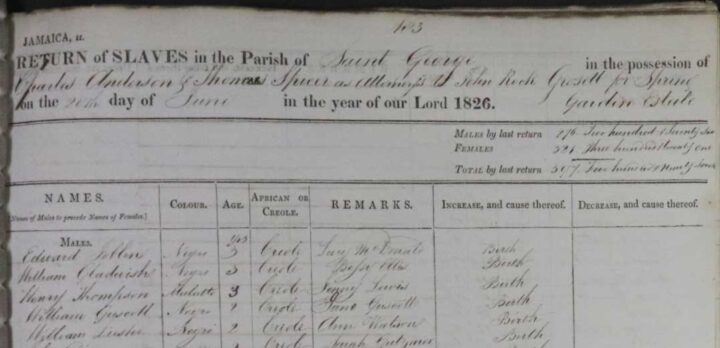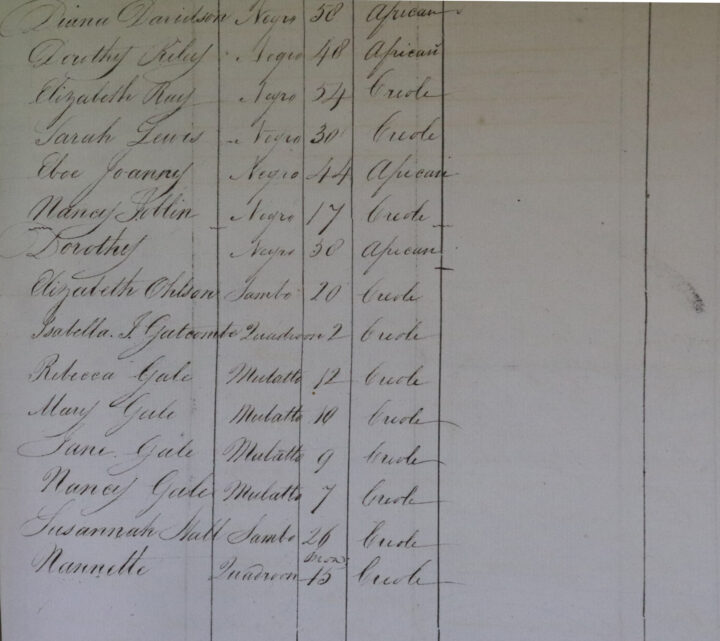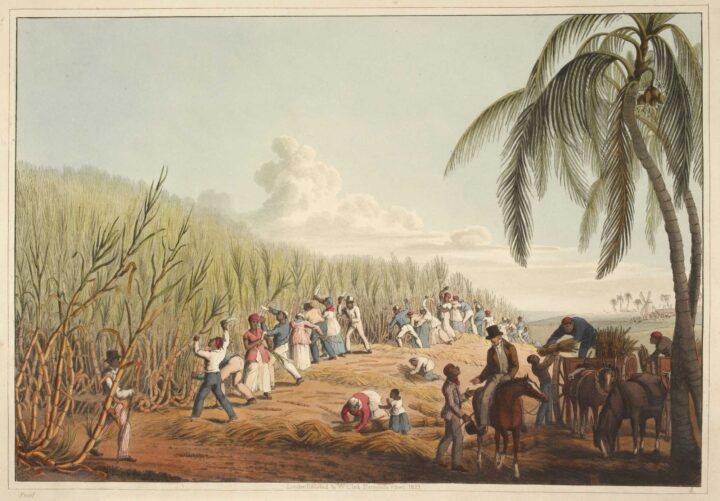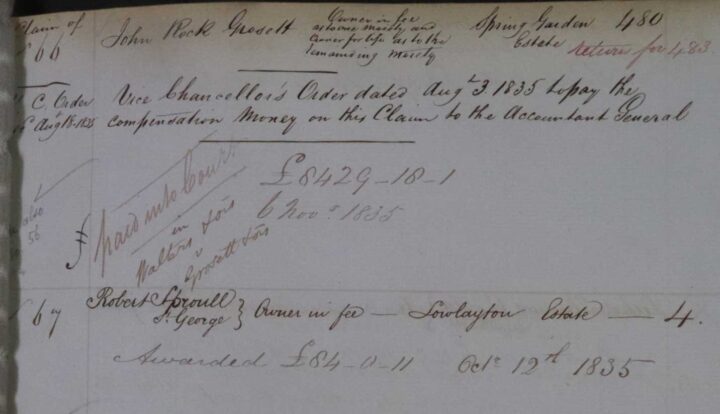
Treasury Office records
We hope you enjoyed watching our Education Service video with Eighteenth Century Records Specialist Philippa Hellawell looking at records from the Treasury. This video focusses on slavery registers from 1826 concerning Jamaica which shed light on colonialism and the slave trade in the British Caribbean.
Our collections contain ideas, language and imagery from original records which reflect historical perspectives and attitudes of the time. Some of this language will be considered offensive. However, we think it important to show them as accurate representations of the record to help us understand the past.
Now try and answer the following questions:
- What was the role of the Treasury Office?
- When was it created?
- What type of material can be found in the Treasury Office collection?
- What is the reference for the document examined in the video?
- What type of document is it? How has it been preserved?
- When did the ‘Office of the Register of Colonial Slaves’ begin?
- What information does the document record?
Document 1a
Extracts from the register of enslaved people at Spring Garden Estate, the parish of Saint George in Jamaica, 1826. The first extract shows the top of a register, and the second extract shows some of the female enslaved women and girls at the same plantation. Catalogue ref: T 71/161, f. 183
Copies of slave registers kept by the colonies were sent to the Office of the Register of Colonial Slaves, which was set up in 1819.
The owner of the plantation and the enslaved people listed was John Rock Grosett, Member of Parliament for Chippenham. His two attorneys (lawyers) filled out the return on his behalf.
Some of the language used in this document to categorise different individuals is considered racist.
The term ‘race’ can be considered as a social construct (meaning something that has come about through complex social and political processes, rather than being grounded in science). Therefore, language relating to it depends on its context in time and location and is often contested and frequently problematic.
The following definitions provide information about how the different social groups described in this document were racialised (given often negatively evaluated characteristics on account of their ethnic backgrounds) in a system a of racial classification. and discrimination. These terms have complex historical and cultural meanings and may not be used in the same way in all regions or contexts.
Definitions for terms used in the document.
‘Mulatto’ is used to refer to people of mixed African and European ancestry.
‘Creole’ as a term was used to describe people of mixed European and Black African descent born in the colonies often born in the Americas. Creole also can mean a language that has arisen from simplifying and mixing different languages.
‘Quadroon’ or ‘quarteron’ in the colonial societies of the Americas and Australia was a person with one quarter African/Aboriginal and three quarters European ancestry.
‘Sambo’ as a term was used in a broader sense as a derogatory term for black people, though here it seems to be used as a racial category to refer a person of mixed African and European or Indigenous American ancestry in Spanish/Latin America.
- Find the name of the plantation and the name of the plantation owner.
- How many enslaved men and women are recorded working on this plantation?
- What is the total?
- How would the increase and decrease of the enslaved normally be recorded?
- What do these first entries on the register reveal about those enslaved?
Transcript:
Jamaica RETURN of SLAVES in the Parish of St George in the possession of
Charles Anderson & Thomas Spicer as Attorneys to John Rock Grosett in the Spring Garden Estate
On the day 28th day of June in the year of Lord 1826
MALES by last return 276 Two hundred & seventy-six.
FEMALES 321 Three hundred & twenty-one
TOTAL by last return 597 Five hundred and ninety-seven
| NAMES
Names of males to precede names of Females. |
COLOUR | AGE
Yrs |
AFRICAN OR CREOLE | REMARKS | INCREASE, and cause thereof. | DECREASE, and cause thereof. |
| Edward Toblin | Negro | 3 | Creole | Lucy M Donato | Birth | |
| William Gladwish | Negro | 3 | Creole | Betsy Ellis | Birth | |
| Henry Thompson | Mulatto | 3 | Creole | Jenny Lewis | Birth | |
| William Gursell | Negro | 2 | Creole | Jane Gursell | Birth | |
| William Lister | Negro | 2 | Creole | Ann Watson | Birth |
Document 1b
Extracts from the register of enslaved people at Spring Garden Estate, the parish of Saint George in Jamaica, 1826. The first extract shows the top of a register, and the This second extract shows some of the female enslaved women and girls at the same plantation. Catalogue ref: T 71/161, f. 183
- From looking at both parts of the document what does the language used to categorise and describe individuals reveal about attitudes towards race at the time? [Clue: also see caption information].
- How many sisters appear to be listed in this second extract?
- What is the age of the oldest female listed here?
- The slave trade itself was banned in 1807. Why do you think therefore, that these registers were kept recording the existing enslaved people working on plantations?
- What information does this register reveal about the enslaved?
- What does the register reveal about British attitudes towards the system of slavery?
- What information does this document not reveal about the system of slavery in the British Empire? Explain why.
Transcript
| Diana Davidson | Negro | 58 | African |
| Dorothy Riley | Negro | 48 | African |
| Elizabeth Ray | Negro | 54 | Creole |
| Sarah Lewis | Negro | 30 | Creole |
| Eboe Joanny | Negro | 44 | African |
| Nancy Toblin | Negro | 17 | Creole |
| Dorothy | Negro | 38 | African |
| Elizbeth Ohlson | Sambo | 20 | Creole |
| Isabella Gatcombe | Quadroon | 2 | Creole |
| Rebecca Gale | Mulatto | 12 | Creole |
| Mary Gale | Mulatto | 10 | Creole |
| Jane Gale | Mulatto | 9 | Creole |
| Nancy Gale | Mulatto | 7 | Creole |
| Susannah Hall | Sambo | 21 mons | Creole |
| Nannette | Quadroon | 15 | Creole |
Document 2
Image entitled ‘Sugar Cane Harvest, Antigua, West Indies’, 1823 from ‘Ten Views in the Island of Antigua in Which are Represented the Process of Sugar Making…. From Drawings Made by William Clark, During a Residence of Three Years in the West Indies’ (London,1823). Plate IV. © British Library, Wikimedia Commons.
Clark might have managed or overseen plantations in Antigua, the prints in the collection were probably based on his drawings. For further examples see A Visual Record of the African Slave Trade and Slave Life in the Early African Diaspora . Also find out more about images seen in our video by James Hakewill from his ‘A picturesque tour of the island of Jamaica, from drawings made in the years 1820 and 1821’. Picturesque is a style of landscape painting.
This image shows cutting the sugar cane on Delap’s Estate, Antigua. Use a map to check the location of Antigua, another British island sugar colony in the Caribbean.
- How are these enslaved workers organised to cut the sugar cane?
- How are they supervised?
- What is the role of the manager/overseer on horse-back?
- What other information does this image infer?
- What perspective does/does not this image reveal about the enslaved themselves?
- Why do you think this image was produced?
- What is the value of looking at this image alongside Document 1 in terms of understanding this topic?
- What other sources, beyond Treasury Office records, would be important to explore when studying this topic?
Document 3
Extract of a Treasury Department payment warrant which paid compensation the enslaver, John Rock Grosett mentioned in the slave register extract, Document 1. Catalogue ref: T 71/869, n. 66
The Slave Compensation Commission used the registers as the basis to calculate how much compensation was owed to enslavers when the enslaved were freed. Once the information had been collected from the registers of the enslaved, the Treasury issued a payment warrant for each individual enslaver to be paid by the National Debt Office. This often involved the Treasury, which explains how these records are present in the Treasury collection.
- How much compensation did John Rock Grosett receive in 1835?
- What is the value of the compensation today as expressed in our video?
- How would you explain the difference in number of enslaved people recorded on the document? [Clue: 480 & 483]
- How much was Robert Sproull, also listed here, compensated?
- Why did he receive less compensation?
- What does this document reveal about slavery and the slave trade?
- What is so shocking/surprising about this document?
Transcript
- John Rock Grosett Spring Garden Estate 480. Returns for 483.
Owner in fee as the one moiety and owner for life as to the remaining moiety.
C. Order 18th August: Vice Chancellors order dated August 3, 1835, to pay the compensation money on the claim to the Accountant General
£8429-18-1
6 November 1835
Paid into Court in Walters Lois v Grosett & Sons?
- Robert Sproull, St George [Jamaica] Owner in fee -Lowlayton Estate- 4 [enslaved]
Awarded £84-0-11 October 12th 1835
Connections to curriculum
Key stage 3
Ideas, political power, industry and empire: Britain, 1745-1901: Britain’s transatlantic slave trade: its effects and its eventual abolition
Key stage 4
AQA GCSE History: Britain: Migration, empires and the people: c790 to the present day
Related Resources
- Spotlight on the Baptist War from the Colonial Office.
- A Visual Record of the African Slave Trade and Slave Life in the Early African Diaspora
- https://www.nationalarchives.gov.uk/education/resources/slavery/
- https://www.nationalarchives.gov.uk/education/resources/black-asian-and-minority-ethnic-histories/



